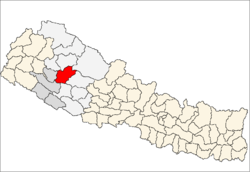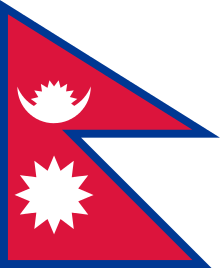Jajarkot District
| Jajarkot जाजरकोट | |
|---|---|
| District | |
 Location of Jajarkot | |
| Country | Nepal |
| Region | Mid-Western (Madhya Pashchimanchal) |
| Zone | Bheri |
| Headquarters | Khalanga |
| Area | |
| • Total | 2,230 km2 (860 sq mi) |
| Population (2011) | |
| • Total | 171,304 |
| • Density | 77/km2 (200/sq mi) |
| Time zone | NPT (UTC+5:45) |
Jajarkot District (Nepali: जाजरकोट जिल्ला![]() Listen , a part of Province No. 6, is one of the seventy-five districts of Nepal, a landlocked country of South Asia. The district, with Jajarkot as its district headquarters, covers an area of 2,230 km and had a population of 134,868 in 2001 and 171,304 in 2011.[1] The Northern part of Humla District is inhabited by Buddhists, originating from Tibet, whereas the South is mostly inhabited by Hindus.
Listen , a part of Province No. 6, is one of the seventy-five districts of Nepal, a landlocked country of South Asia. The district, with Jajarkot as its district headquarters, covers an area of 2,230 km and had a population of 134,868 in 2001 and 171,304 in 2011.[1] The Northern part of Humla District is inhabited by Buddhists, originating from Tibet, whereas the South is mostly inhabited by Hindus.
Introduction
Jajarkot is one of the districts of Province No. 6 in Mid-western Nepal. Khalanga is its headquarters. It has 30 village development committee (VDC/s) and each VDC in turn has 9 Wards which are the smallest geographical units. Population: 1,34,868 (CBS 2001), Expected population: 1,51,511 (2009). Area: 2123.83 km2[2]
Now, Cholera outbreak occurred in Jajrkot and death tolled already more than 150 and more than 20,000 people are affected. Due to the Geographical difficulty and inaccessibility to this district, containing Cholera outbreak is becoming difficult. The lack of planning for the outbreak investigation, coordination at regional and district level, lack of management knowledge are the main factors for spreading outbreak from government side, whereas lack of awareness, open field defecation, eating stale food and drinking unsafe water are leading factors from the public part. A team from Nepal Health Research council (Dr. Gajananda Prakash Bhandari, Epidemiologist; Dr. Sameer Dixit, Biotechnologist) headed towards the affected Jajarkot and stayed there and visited interiors of the district, collected data and stool samples. They found that the cause of previously undiagnosed diarrheal disease was Cholera which is caused by "Vibrio Cholerae". Total number of samples collected = 25 Total number of samples positive for Vibrio Cholerae = 13[3]
Geography and Climate
| Climate Zone[4] | Elevation Range | % of Area |
|---|---|---|
| Upper Tropical | 300 to 1,000 meters 1,000 to 3,300 ft. |
5.9% |
| Subtropical | 1,000 to 2,000 meters 3,300 to 6,600 ft. |
37.3% |
| Temperate | 2,000 to 3,000 meters 6,400 to 9,800 ft. |
34.6% |
| Subalpine | 3,000 to 4,000 meters 9,800 to 13,100 ft. |
16.9% |
| Alpine | 4,000 to 5,000 meters 13,100 to 16,400 ft. |
2.3% |
| Nival | above 5,000 meters | 3.0% |
Towns and villages

See also
References
- ↑ "National Population and Housing Census 2011(National Report)" (PDF). Central Bureau of Statistics. Government of Nepal. November 2012. Retrieved November 2012. Check date values in:
|access-date=(help) - ↑ "District Development Committee, Jajarkot".
- ↑ "Jajarkot Nepal: Cholera Outbreak" (PDF).
- ↑ The Map of Potential Vegetation of Nepal - a forestry/agroecological/biodiversity classification system (PDF), . Forest & Landscape Development and Environment Series 2-2005 and CFC-TIS Document Series No.110., 2005, ISBN 87-7903-210-9, retrieved Nov 22, 2013
External links
- "Districts of Nepal". Statoids.
Coordinates: 28°42′00″N 82°14′00″E / 28.7°N 82.2333°E
| Wikimedia Commons has media related to Jajarkot District. |
